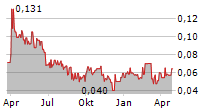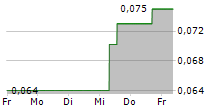HIGHLIGHTS
|
Mike Spreadborough, Executive Co-Chairman and Acting Chief Executive Officer, said: "Results from the RC drill program at the Clone prospect include two intercepts above 40 mxg Au, where drilling has successfully intersected high-grade near-surface gold mineralisation consistent with a shallow plunging shoot. The consistency of grade and thickness over a 300 m strike is very encouraging. Follow up RC drilling to extend gold mineralisation to the north is warranted and is now being designed.
Some 7 km southeast of the Clone prospect, the New Bendigo prospect displays a similar shallow northerly plunge and will also be advanced with structural analysis and interpretation of historic diamond core, in preparation for potential extensional drilling.
Further systematic exploration programs are planned along the full project strike length testing mineralised trends from New Bendigo to Warratta Reef and Pioneer/Phoenix to Clone to identify potential drill targets. Tibooburra remains an exciting exploration project given the extent of the system along a 22 km strike of historic workings, and limited systematic exploration or drilling."
PERTH, Western Australia, July 09, 2025 (GLOBE NEWSWIRE) -- Novo Resources Corp. (Novo or the Company) (ASX: NVO) (TSX: NVO) (OTCQB: NSRPF) is pleased to announce significant high-grade gold results from the Company's maiden drilling program at the Tibooburra Gold Project (Tibooburra) (Figure 1), located in northwestern NSW. The program comprised 14 holes for 1,984 m, testing 500 m of strike at the Clone prospect (Clone).
Tibooburra is an advanced exploration opportunity and covers much of the historic Albert Goldfields. Tenure includes six granted exploration licences over 630 sq km and covers the historic workings over a strike of over 22 km from Phoenix North to New Bendigo.
In late 2024, Novo completed a binding farm-in/JV agreement for Tibooburra with Manhattan Corporation Limited (ASX: MHC) (Manhattan)1. The agreement grants Novo an option to acquire a 70% interest in the tenements comprising the Tibooburra Gold Project, subject to (among other things) Novo meeting two minimum expenditure requirements over two 12-month periods.
Novo met (and exceeded) the required minimum spend of $500,000 for the initial farm in period under the binding term sheet during June 2025.
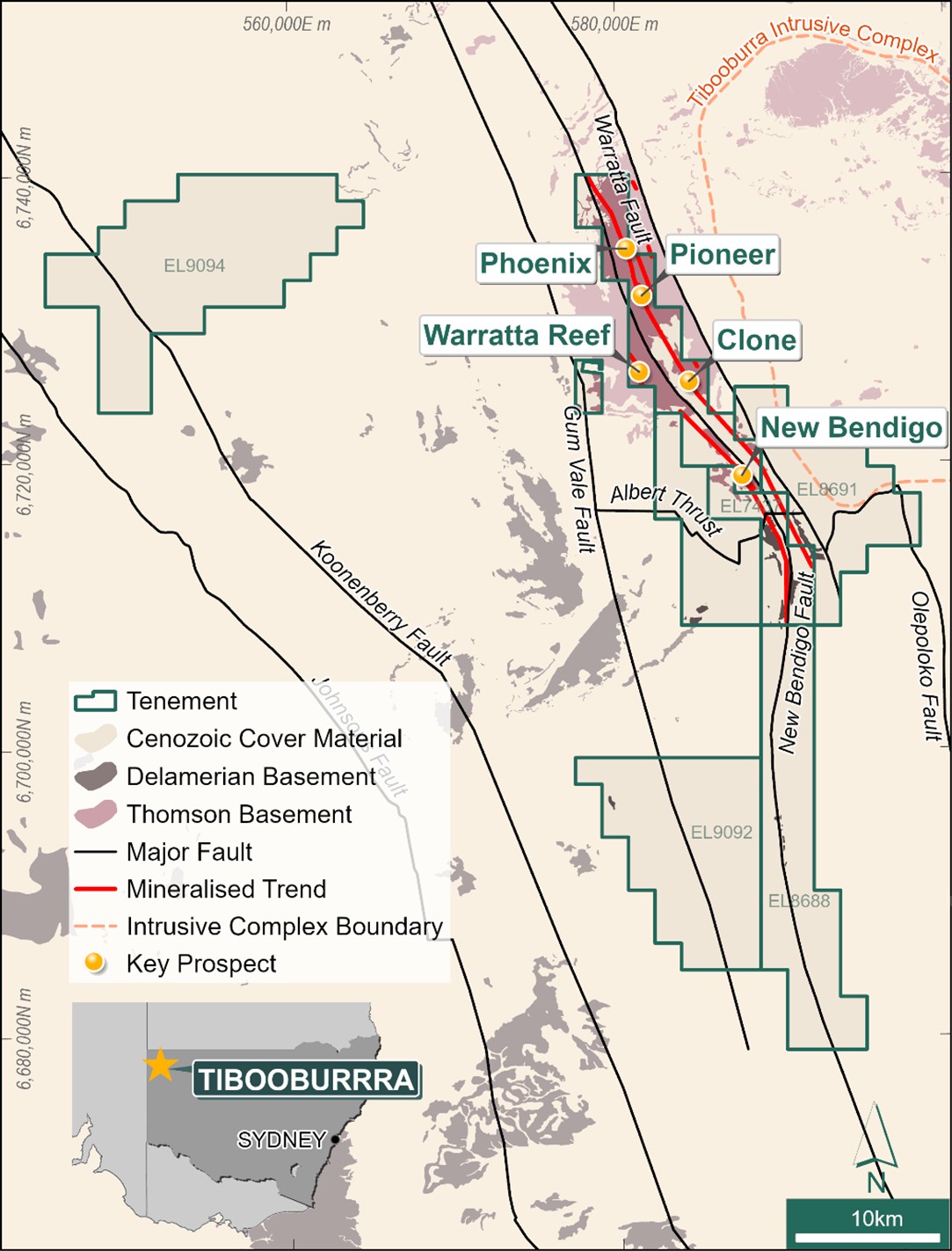
Figure 1 Tibooburra Gold Project location and tenement map, showing main prospects.
Clone Prospect Surface Exploration
Initial exploration completed by Novo in Q1 2025 focused on Clone2 and included detailed structural, lithological and regolith mapping, pXRF analysis of soils and rocks, -80# mesh soil sampling and rock chip sampling.
Novo rock chip sampling returned exceptional peak results of 89.6 g/t Au and 41.9 g/t Au2 from mullock dump samples associated with historical workings, and 31.4 g/t Au and 10.4 g/t Au2 from limited quartz vein outcrop.
Soil sampling defined a ~ 600 m long and up to 250 m wide coherent gold in soil anomaly at > 30 ppb Au, with standout peak results of 1,585 ppb Au and 1,440 ppb Au2.
Mapping defined a west dipping reverse fault/thrust (Clone Thrust) associated with high-grade gold mineralisation. Most historical workings and significant sericite-carbonate alteration are proximal to, or constrained within the fault/shear zone (Figure 2). The turbidite stratigraphy is intensley folded (tight to isoclinal) with most fold axes plunging moderately NNW. The intersection of regional foliation and the main structures, provide a shallow north to NNE plunging intersetion, similar to the high-grade shoot plunge defined by the recent drilling.
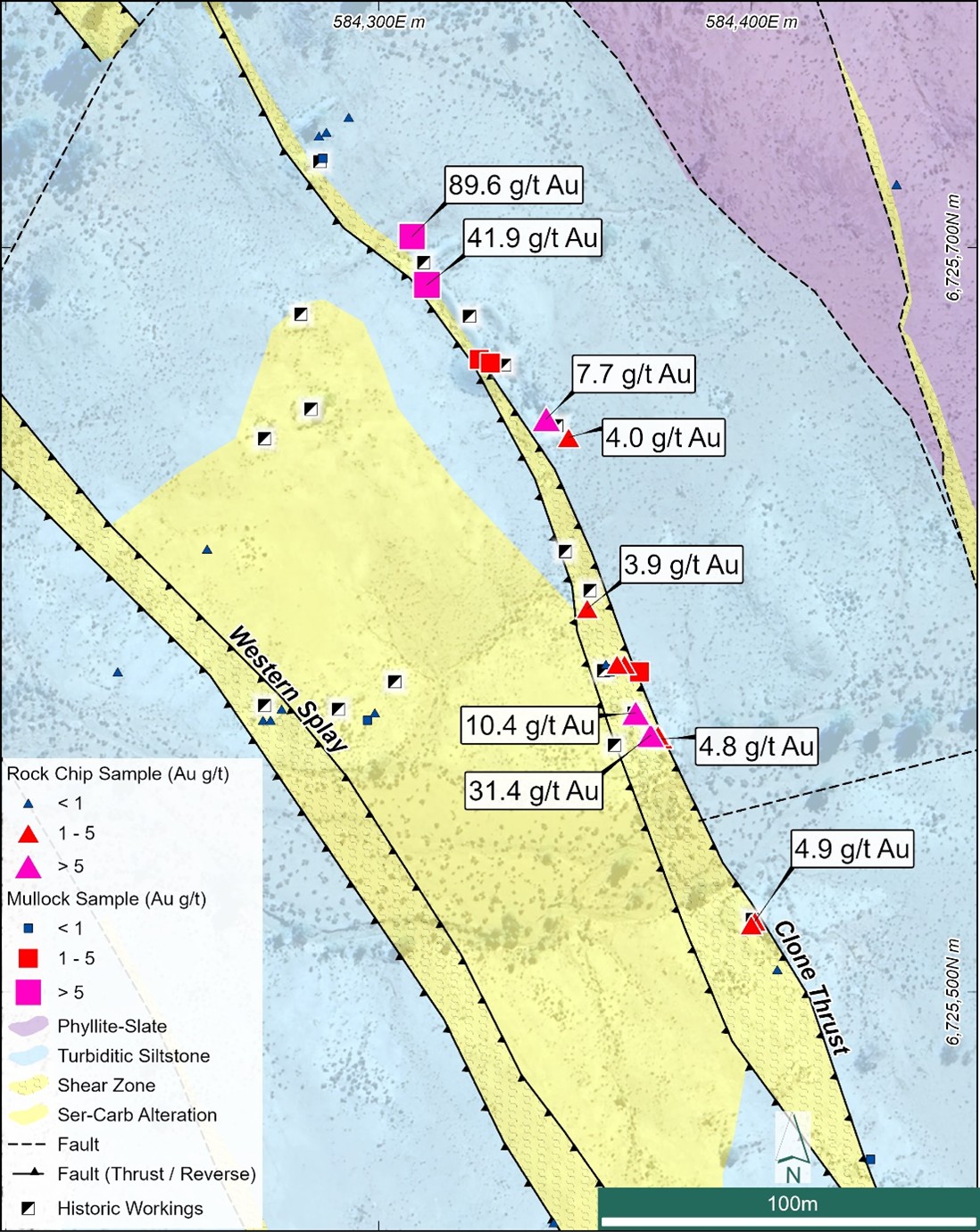
Figure 2 Clone historic workings, geological interpretation and surface rock chip results 2.
Clone Prospect RC Drill Program
RC drilling was completed at Clone in May 2025, with 14 holes drilled for 1,984 m on approximately 60 m to 150 m spaced sections (Figure 3, 4 and 5).
The program was designed to test 500 m strike of Clone in the main area of historical workings, informed by Novo's geological mapping and sampling and historical drilling by Manhattan3.
Significant results from the RC drill program include:
- 12 m @ 5.90 g/t Au from 16 m including 5 m @ 13.74 g/t Au from 23 m (TBR0001)
- 17 m @ 2.40 g/t Au from 59 m including 9 m @ 4.14 g/t Au from 59 m (TBR0014)
The results show grade and width continuity similar to the original Manhattan RC drilling and support a near-surface shoot of north-plunging high-grade gold mineralisation, now defined over 300 m strike (Figure 6).
Drill testing was designed to best intersect interpreted mineralised trends and structures at right angles to minimise bias in sample collection. All intervals are reported as down hole widths, as true orientation of mineralisation is still unknown.
Historical drilling completed by Manhattan in 2023, highlighted potential for shallow dipping high-grade gold mineralisation, testing to a maximum depth of 75 m, with significant drill results returned from eleven holes including:
- 6 m @ 8.39 g/t Au from 82 m (CL0007)
- 9 m at 6.03 g/t Au from 16 m (CL0010)
- 6 m at 4.22 g/t Au from 66 m, including 4 m @ 6.21 g/t Au from 68 m (CL0004)
- 29 m @ 1.37 g/t Au from 61 m, including 19 m @ 1.81 g/t Au from 62 m Au (CL0002)
Broad zones of lower grade mineralisation were also intersected, highlighting the gold fertility of the structural corridor. Drill intercepts from both Novo and Manhattan support this model and include:
- 10 m @ 0.45 g/t Au from 105 m (TBR0013)
- 23 m @ 0.51 g/t Au from 71 m (CL0001)
- 14 m @ 0.5 g/t Au from 17 m (CL0005)
- 10 m @ 0.53 g/t Au from 57 m (CL0007)
Refer Appendix 1 for all drill collar information, and Appendices 2 and 3 for all significant drill assay results.
New Bendigo Prospect
New Bendigo is an advanced target at Tibooburra approximately 7 km southeast of Clone, and along a parallel trend. This was the focus area for Manhattan's drilling programs. The prospect is mostly under cover but has several shafts and extensive historical workings over 2 km strike.
Multiple high-grade gold intercepts were defined during several drill programs by Manhattan at New Bendigo, where peak drill results include:
- 30 m at 4.03 g/t Au from 11 m, including 5 m at 20.86 g/t Au (NB0033)1
- 16 m at 13.89 g/t Au from 1 m, including 3 m at 69.20 g/t Au (NB0083)1
- 8 m at 40.5 g/t Au from 70 m, including 3 m at 105.34 g/t Au (NB0089)1
- 7 m at 13.10 g/t Au from 97 m, including 5 m at 18.01 g/t Au (NB0113)1
- 13 m at 6.16 g/t Au from 50 m, including 3 m at 25.48 g/t Au (NB0122)1
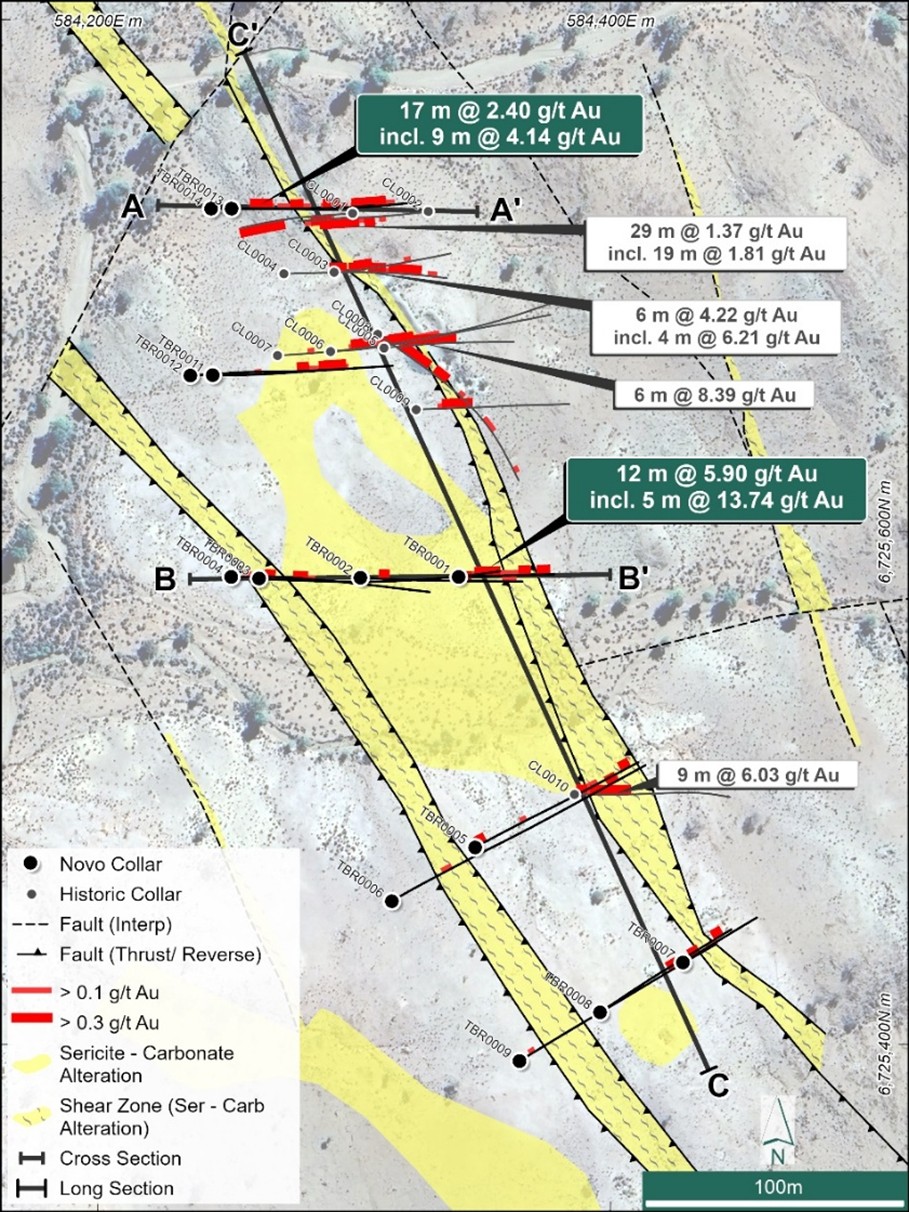
Figure 3 Significant intercepts from Novo (green callout) and Manhattan (white callout) RC drilling programs, dill hole and section location and geological interpretation
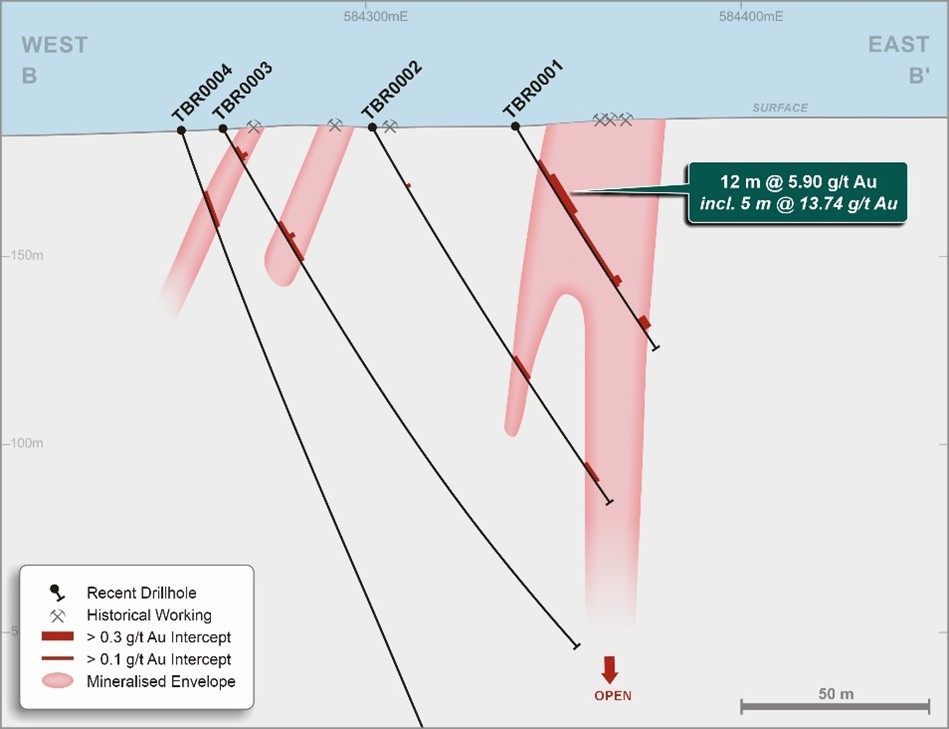
Figure 4 Clone drill sections with interpreted mineralised envelope and drill intercepts (green callout Novo drilling, grey callout Manhattan drilling) - see Figure 3 for location
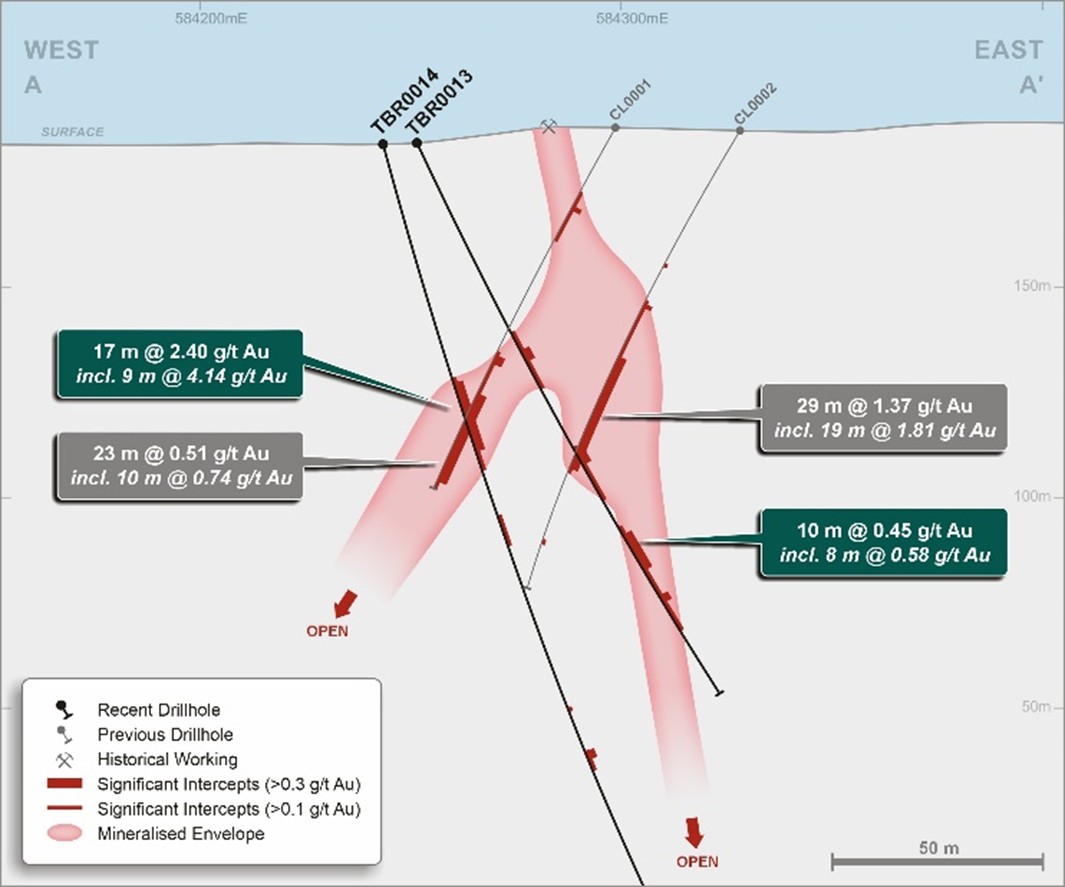
Figure 5 Clone drill sections with interpreted mineralised envelope and drill intercepts (green callout Novo drilling, grey callout Manhattan drilling) - see Figure 3 for location
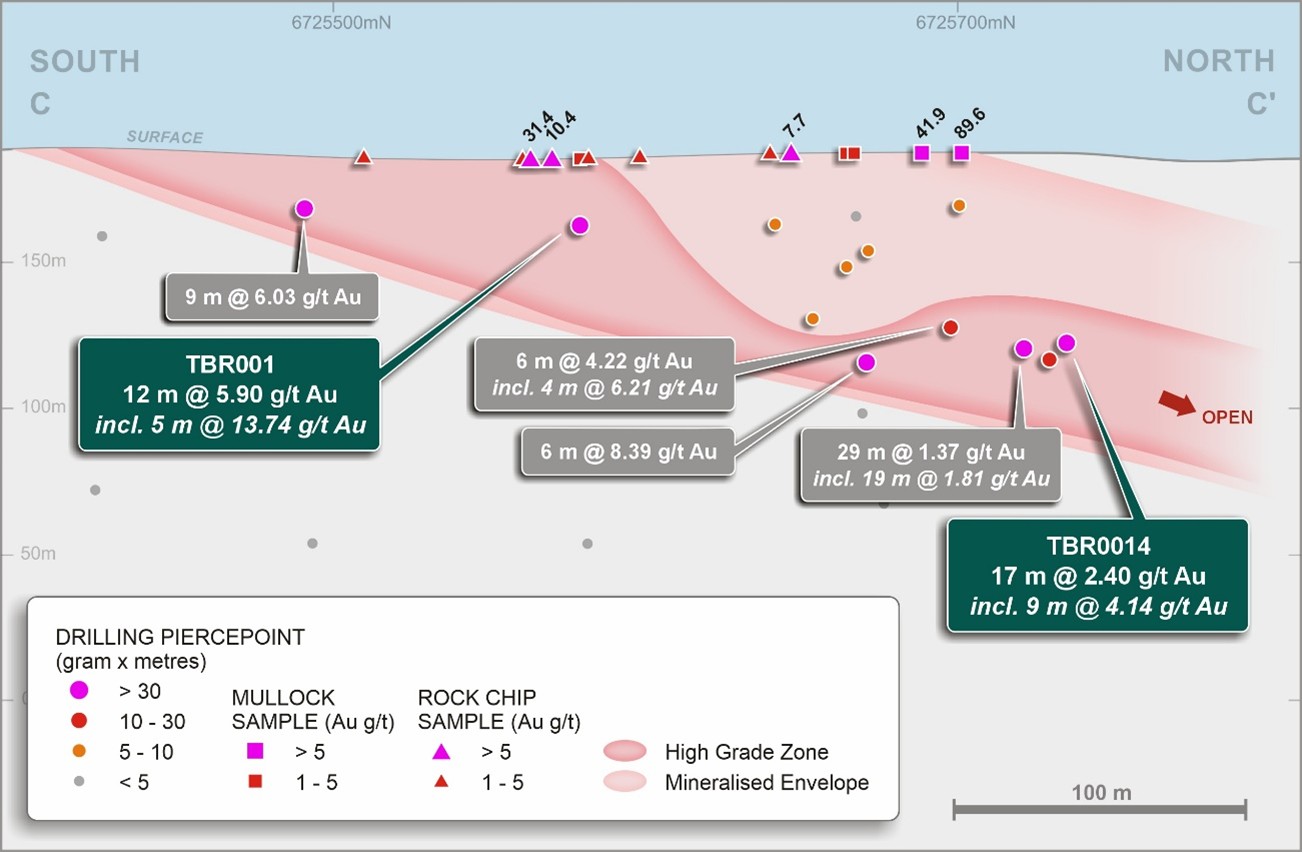
Figure 6 Clone interpreted long section highlighting grade and width continuity, shallow north plunge to the high-grade shoot and mineralising system open to the north (green callout Novo drilling, grey callout Manhattan drilling) - see Figure 3 for location
There is potential for repeated lodes at depth and along the interpreted shallow northerly plunge at New Bendigo, however controls on gold mineralisation are not yet fully understood. Figure 7 shows current interpretation of grade from historical drilling, clearly delineating a northern plunge control on the long section.
Novo has not conducted data verification (as that term is defined in National Instrument 43-101 Standards of Disclosure for Mineral Projects and JORC 2012) in respect of the above data from New Bendigo and therefore is not to be regarded as reporting, adopting or endorsing those results/figures. No assurance can be given that Novo will achieve similar results.
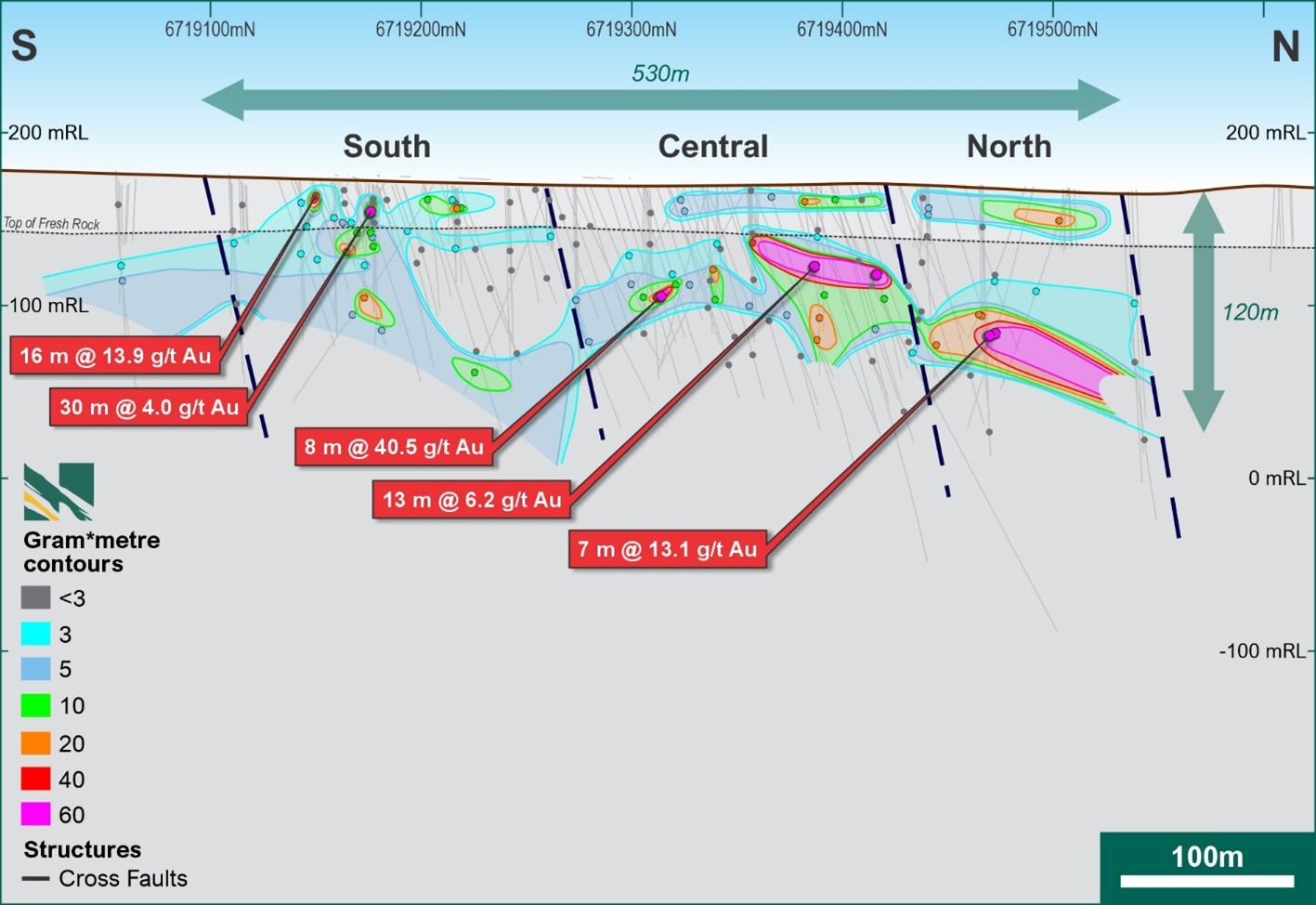
Figure 7 Long section interpretation at New Bendigo by Novo, based on historical data.
Tibooburra Geological Model
The mineralisation at Tibooburra is classified as an orogenic gold system hosted within a turbidite-dominated sequence, sharing key structural and geological similarities with the turbidite-hosted gold deposits of Central Victoria's Western Lachlan Orogen (Figure 8). The historic workings at Tibooburra extend over 22 km along strike.
Similarities between Tibooburra and Central Victoria include moderate west dipping mineralised reverse faults, tight shallow plunging folds, age of the host rocks, mineralisation styles and structural deformation history. The current understanding of the Clone and New Bendigo prospects provides several possibilities for the detailed mineralisation style (Figure 8) and structural control on the high-grade shoots.
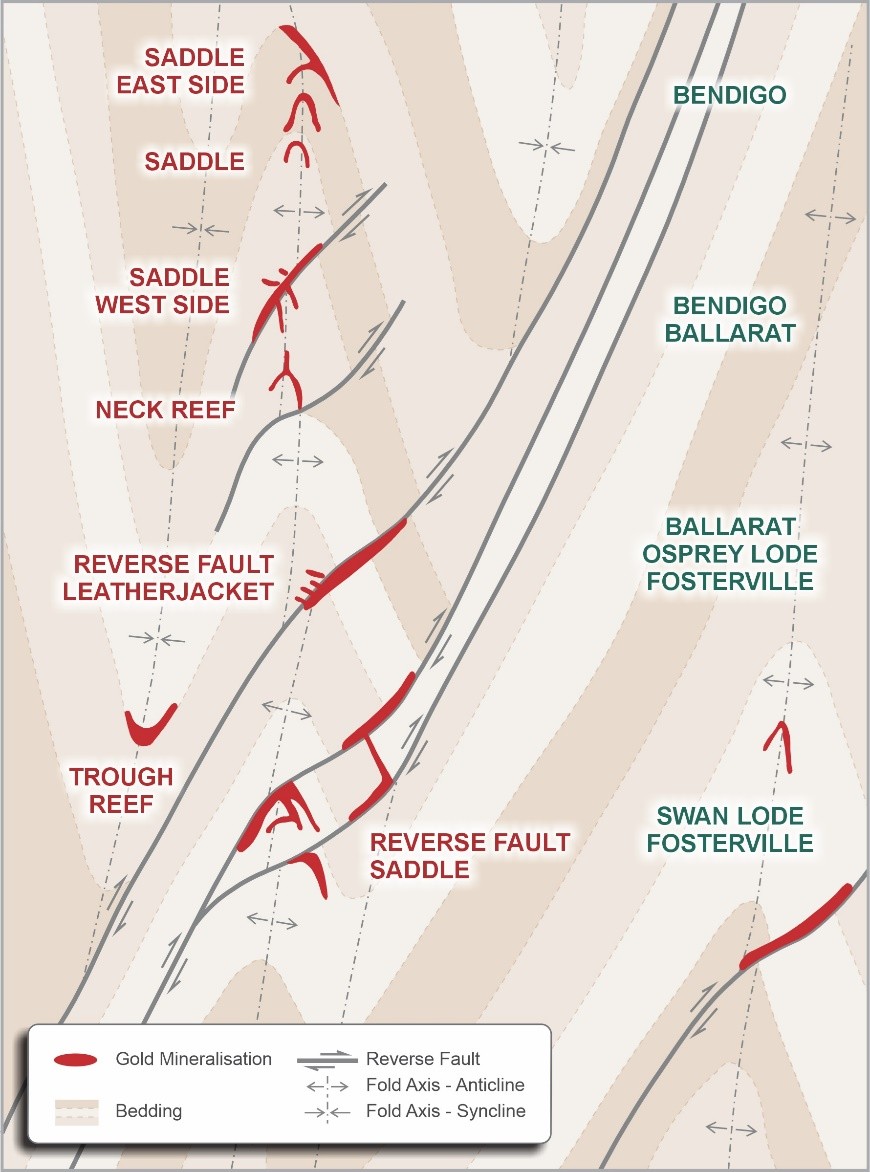
Figure 8 Simplified structural model for orogenic turbidite-hosted gold deposits of Central Victoria (not depth specific) and examples of these deposits in Victoria (modified and adapted from W.R.H Ramsay et al 1998 and Hitchman et al 2017).
This rationale, adapted from Ramsay et al. (1998), Hitchman et al. (2017), and Greenfield and Reid (2006)4, underscores Tibooburra's potential as an orogenic gold system, with exploration focused on structurally controlled targets analogous to the Victorian Goldfields.
While Novo believes such similarities exist, no assurance can be given that Novo will achieve similar results at its Tibooburra Project.
Forward Program
Next steps at Tibooburra include designing follow up RC drilling at Clone to test the northern extension of the high-grade shoot defined by Novo over 300 m strike in recent drilling. In addition, planned work at Clone includes down hole imaging to determine if structural data (vein orientations) can be obtained, and whether this provides a useful basis for structural targeting.
Relogging of core from New Bendigo is also planned to better identify controls on gold mineralisation at the prospect. New Bendigo displays a similar shallow northerly plunge to Clone and will also be assessed for extensional RC drilling.
Further and broader scale work at Tibooburra will be systematic and will focus on understanding the belt-wide structural controls on gold mineralisation by mapping and sampling the northern extension of the Clone Trend at Pioneer / Phoenix, and by mapping the Waratah Reef and southern New Bendigo areas.
Authorised for release by the Board of Directors.
CONTACT
| Investors: Mike Spreadborough +61 8 6400 6100 info@novoresources.com | North American Queries: Leo Karabelas +1 416 543 3120 leo@novoresources.com | Media: Cameron Gilenko +61 466 984 953 cameron.gilenko@sodali.com |
QP STATEMENT
Mrs Karen (Kas) De Luca (MAIG), is the qualified person, as defined under National Instrument 43-101 Standards of Disclosure for Mineral Projects, responsible for, and having reviewed and approved, the technical information contained in this news release. Mrs De Luca is Novo's General Manager Exploration.
JORC COMPLIANCE STATEMENT
The information in this news release that relates to new exploration results at Tibooburra is based on information compiled by Mrs De Luca, who is a full-time employee of Novo Resources Corp. Mrs De Luca is a Competent Person, as defined in the 2012 Edition of the 'Australasian Code for Reporting of Exploration Results, Mineral Resources and Ore Reserves', who is a member of the Australian Institute of Geoscientists. Mrs De Luca has sufficient experience that is relevant to the style of mineralisation and the type of deposits under consideration and to the activity being undertaken to qualify as a Competent Person. Mrs De Luca consents to the inclusion in the report of the matters based on her information in the form and context in which it appears.
The information in this news release that relates to previously reported exploration results at the Tibooburra Project is extracted from:
(a) Novo's ASX announcement entitled "Novo Strengthens Portfolio with Two High-Grade Gold Projects in NSW, Australia" released to ASX on 13 December 2024; and
(b) Novo's ASX announcement entitled "Promising Surface Exploration Informs Tibooburra RC Drilling Program" released to ASX on 2 April 2025,
each of which is available to view at www.asx.com.au. The Company confirms that it is not aware of any new information or data that materially affects the information included in the original market announcement and that all material assumptions and technical parameters underpinning the estimates in the announcements continue to apply and have not materially changed. The Company confirms that the form and context in which the competent persons findings are presented have not been materially modified from the original market announcements.
FORWARD-LOOKING STATEMENTS
Some statements in this news release may contain "forward-looking statements" within the meaning of Canadian and Australian securities law and regulations. In this news release, such statements include but are not limited to planned exploration activities and the timing of such. These statements address future events and conditions and, as such, involve known and unknown risks, uncertainties and other factors which may cause the actual results, performance or achievements to be materially different from any future results, performance or achievements expressed or implied by the statements. Such factors include, without limitation, customary risks of the resource industry and the risk factors identified in Novo's annual information form for the year ended December 31, 2024 (which is available under Novo's profile on SEDAR+ at www.sedarplus.ca and at www.asx.com.au) and in the Company's prospectus dated 2 August 2023 which is available at www.asx.com.au. Forward-looking statements speak only as of the date those statements are made. Except as required by applicable law, Novo assumes no obligation to update or to publicly announce the results of any change to any forward-looking statement contained or incorporated by reference herein to reflect actual results, future events or developments, changes in assumptions or changes in other factors affecting the forward-looking statements. If Novo updates any forward-looking statement(s), no inference should be drawn that the Company will make additional updates with respect to those or other forward-looking statements.
___________________
1 Refer to ASX news release by Novo Resources dated 13/12/2024 - Novo Strengthens Portfolio with Two High-Grade Gold Projects in NSW, Australia.
2 Refer to ASX news release by Novo Resources dated 02/04/2025 - Promising Surface Exploration Informs Tibooburra RC Drilling Program
3 Refer to ASX news release by Manhattan Corp dated 10/07/2023 - New High-Grade Gold Discovery
- 4 Greenfield J & Reid W, 2006. Orogenic gold in the Tibooburra area of northwestern NSW- a ~440 Ma ore system with comparison to the Victorian Goldfields, ASEG Extended Abstracts, 2006:1, 1-8
- Ramsay W.R.H, Bierlein F.P, Arne D.C and Vanden Berg A.H.M, 1998. Turbidite-hosted gold deposits of Central Victoria, Australia: their regional setting, mineralising styles, and some genetic constraints, Ore Geology Reviews, Volume 13, Issues 1-5, 1998, Pages 131-151
- Hitchman, S.P., Phillips, N.J. and Greenberger, O.J., 2017 - Fosterville gold deposit: in Phillips, G.N., (Ed.), 2017 Australian Ore Deposits, The Australasian Institute of Mining and Metallurgy, Mono 32, pp. 791-796.
ABOUT NOVO
Novo is an Australian based gold explorer listed on the ASX and the TSX focussed on discovering standalone gold and copper projects with > 1 Moz development potential. Novo is an innovative gold explorer with a significant land package covering approximately 5,500 square kilometres in the Pilbara region of Western Australia, along with the 22 square kilometre Belltopper project in the Bendigo Tectonic Zone of Victoria, Australia.
Novo's key project area in the Pilbara is the Egina Gold Camp, where Northern Star Resources Limited (ASX: NST) is farming-in to form a JV at the Becher Project and surrounding tenements through exploration expenditure of A$25 million within 4 years for a 50% interest. The Becher Project has similar geological characteristics as Northern Star's 12.7 Moz Hemi Project#. Novo is also advancing gold exploration south of Becher in the Egina Gold Camp, part of the Croydon JV (Novo 70%: Creasy Group 30%). Novo continues to undertake early-stage exploration elsewhere across its Pilbara tenement portfolio.
Novo has also formed a lithium joint venture with SQM in the Pilbara which provides shareholder exposure to battery metals.
Novo has recently strengthened its high-quality, Australian based exploration portfolio by adding the TechGen John Bull Gold Project in the New England Orogen of NSW, and Manhattan Tibooburra Gold Project in the Albert Goldfields in northwestern NSW. Both projects demonstrate prospectivity for significant discovery and resource definition and align with Novo's strategy of identifying and exploring projects with > 1 Moz Au potential. These high-grade gold projects compliment the landholding consolidation that forms the Toolunga Project in the Onslow District in Western Australia.
Novo has a significant investment portfolio and a disciplined program in place to identify value accretive opportunities that will build further value for shareholders.
Please refer to Novo's website for further information including the latest corporate presentation.
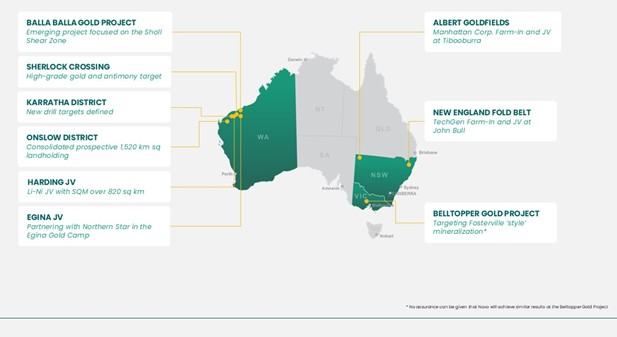
Refer to De Grey's ASX Announcement, Hemi Gold Project mineral Resource Estimate (MRE) 2024, dated 14 November 2024. No assurance can be given that a similar (or any) commercially viable mineral deposit will be determined at Novo's Becher Project.
Appendix 1: Collar locations for the Tibooburra RC program at Clone. All coordinates are in MGA1994, zone 54
| Hole ID | Type | Depth (m) | Easting (m) | Northing (m) | Height (m ASL) | Dip ° | Azimuth ° (grid) |
| TBR0001 | RC | 70 | 584,340 | 6,725,581 | 185 | -60 | 90 |
| TBR0002 | RC | 118 | 584,302 | 6,725,581 | 184 | -61 | 94 |
| TBR0003 | RC | 167 | 584,262 | 6,725,580 | 184 | -61 | 94 |
| TBR0004 | RC | 205 | 584,251 | 6,725,581 | 183 | -71 | 89 |
| TBR0005 | RC | 137 | 584,347 | 6,725,475 | 186 | -61 | 62 |
| TBR0006 | RC | 185 | 584,314 | 6,725,454 | 186 | -62 | 59 |
| TBR0007 | RC | 65 | 584,428 | 6,725,430 | 188 | -60 | 58 |
| TBR0008 | RC | 113 | 584,395 | 6,725,411 | 188 | -61 | 56 |
| TBR0009 | RC | 155 | 584,364 | 6,725,392 | 188 | -61 | 59 |
| TBR0010 | RC | 101 | 584,474 | 6,725,271 | 184 | -61 | 60 |
| TBR0011 | RC | 137 | 584,244 | 6,725,660 | 185 | -62 | 90 |
| TBR0012 | RC | 191 | 584,235 | 6,725,660 | 184 | -76 | 88 |
| TBR0013 | RC | 149 | 584,252 | 6,725,725 | 184 | -66 | 91 |
| TBR0014 | RC | 191 | 584,244 | 6,725,725 | 184 | -76 | 89 |
Appendix 2: Significant intercepts greater than 0.5 gram*metres for the Novo RC program at Clone, using a 0.3 g/t cut-off and 3 m consecutive internal waste. Internal zones of high grade are based on a 0.5 g/t cut off and 2 m consecutive internal waste resulting in > 1 gram * metre
| Hole ID | From (m) | To (m) | Interval (m) | Au (g/t) | Gram x metre Au | Intercept |
| TBR0001 | 16 | 28 | 12 | 5.90 | 70.8 | 12 m @ 5.9 g/t Au from 16 m |
| including | 23 | 28 | 5 | 13.74 | 68.7 | 5 m @ 13.74 g/t Au from 23 m |
| TBR0001 | 48 | 50 | 2 | 0.41 | 0.8 | 2 m @ 0.41 g/t Au from 48 m |
| TBR0001 | 61 | 64 | 3 | 0.44 | 1.3 | 3 m @ 0.44 g/t Au from 61 m |
| TBR0003 | 8 | 9 | 1 | 0.83 | 0.8 | 1 m @ 0.83 g/t Au from 8 m |
| TBR0003 | 33 | 34 | 1 | 0.50 | 0.5 | 1 m @ 0.5 g/t Au from 33 m |
| TBR0005 | 6 | 7 | 1 | 0.89 | 0.9 | 1 m @ 0.89 g/t Au from 6 m |
| TBR0005 | 127 | 128 | 1 | 0.56 | 0.6 | 1 m @ 0.56 g/t Au from 127 m |
| TBR0008 | 103 | 104 | 1 | 3.79 | 3.8 | 1 m @ 3.79 g/t Au from 103 m |
| TBR0009 | 141 | 142 | 1 | 0.76 | 0.8 | 1 m @ 0.76 g/t Au from 141 m |
| TBR0011 | 71 | 73 | 2 | 1.47 | 2.9 | 2 m @ 1.47 g/t Au from 71 m |
| TBR0011 | 87 | 90 | 3 | 0.35 | 1.1 | 3 m @ 0.35 g/t Au from 87 m |
| TBR0011 | 99 | 100 | 1 | 0.49 | 0.5 | 1 m @ 0.49 g/t Au from 99 m |
| TBR0013 | 55 | 58 | 3 | 0.47 | 1.4 | 3 m @ 0.47 g/t Au from 55 m |
| TBR0013 | 82 | 86 | 4 | 1.64 | 6.6 | 4 m @ 1.64 g/t Au from 82 m |
| including | 83 | 86 | 3 | 2.05 | 6.2 | 3 m @ 2.05 g/t Au from 83 m |
| TBR0013 | 105 | 115 | 10 | 0.45 | 4.5 | 10 m @ 0.45 g/t Au from 105 m |
| including | 110 | 115 | 5 | 0.58 | 2.9 | 5 m @ 0.58 g/t Au from 110 m |
| TBR0013 | 122 | 124 | 2 | 0.93 | 1.9 | 2 m @ 0.93 g/t Au from 122 m |
| including | 123 | 124 | 1 | 1.54 | 1.5 | 1 m @ 1.54 g/t Au from 123 m |
| TBR0014 | 59 | 76 | 17 | 2.40 | 40.8 | 17 m @ 2.4 g/t Au from 59 m |
| including | 59 | 68 | 9 | 4.14 | 37.2 | 9 m @ 4.14 g/t Au from 59 m |
| And | 73 | 76 | 3 | 0.78 | 2.3 | 3 m @ 0.78 g/t Au from 73 m |
| TBR0014 | 152 | 154 | 2 | 0.52 | 1.0 | 2 m @ 0.52 g/t Au from 152 m |
Appendix 3: Significant intercepts greater than 0.5 gram*metres recalculated for the Manhattan 2023 RC program at Clone, using a 0.3 g/t cut-off and 3 m consecutive internal waste. Internal zones of high grade are based on a 0.5 g/t cut off and 2 m consecutive internal waste resulting in > 1 gram * metre
| Hole ID | From (m) | To (m) | Interval (m) | Au (g/t) | Gram x metre Au | Intercept |
| CL0001 | 21 | 22 | 1 | 0.72 | 0.7 | 1 m @ 0.72 g/t Au from 21 m |
| CL0001 | 61 | 63 | 2 | 0.64 | 1.3 | 2 m @ 0.64 g/t Au from 61 m |
| CL0001 | 71 | 94 | 23 | 0.51 | 11.7 | 23 m @ 0.51 g/t Au from 71 m |
| including | 74 | 84 | 10 | 0.74 | 7.4 | 10 m @ 0.74 g/t Au from 74 m |
| CL0002 | 47 | 48 | 1 | 1.48 | 1.5 | 1 m @ 1.48 g/t Au from 47 m |
| CL0002 | 61 | 90 | 29 | 1.37 | 39.6 | 29 m @ 1.37 g/t Au from 61 m |
| including | 62 | 81 | 19 | 1.81 | 34.4 | 19 m @ 1.81 g/t Au from 62 m |
| And | 84 | 90 | 6 | 0.58 | 3.5 | 6 m @ 0.58 g/t Au from 84 m |
| CL0003 | 18 | 24 | 6 | 1.05 | 6.3 | 6 m @ 1.05 g/t Au from 18 m |
| including | 18 | 22 | 4 | 1.43 | 5.7 | 4 m @ 1.43 g/t Au from 18 m |
| CL0004 | 43 | 44 | 1 | 1.85 | 1.9 | 1 m @ 1.85 g/t Au from 43 m |
| CL0004 | 52 | 54 | 2 | 0.33 | 0.7 | 2 m @ 0.33 g/t Au from 52 m |
| CL0004 | 66 | 72 | 6 | 4.22 | 25.3 | 6 m @ 4.22 g/t Au from 66 m |
| including | 68 | 72 | 4 | 6.21 | 24.8 | 4 m @ 6.21 g/t Au from 68 m |
| CL0004 | 81 | 82 | 1 | 0.49 | 0.5 | 1 m @ 0.49 g/t Au from 81 m |
| CL0004 | 86 | 89 | 3 | 0.34 | 1.0 | 3 m @ 0.34 g/t Au from 86 m |
| CL0004 | 95 | 98 | 3 | 0.42 | 1.3 | 3 m @ 0.42 g/t Au from 95 m |
| CL0005 | 17 | 31 | 14 | 0.50 | 7.0 | 14 m @ 0.50 g/t Au from 17 m |
| including | 17 | 18 | 1 | 1.00 | 1.0 | 1 m @ 1.00 g/t Au from 17 m |
| And | 21 | 28 | 7 | 0.61 | 4.3 | 7 m @ 0.61 g/t Au from 21 m |
| CL0005 | 35 | 39 | 4 | 0.55 | 2.2 | 4 m @ 0.55 g/t Au from 35 m |
| CL0005 | 44 | 49 | 5 | 1.63 | 8.2 | 5 m @ 1.63 g/t Au from 44 m |
| including | 44 | 48 | 4 | 1.95 | 7.8 | 4 m @ 1.95 g/t Au from 44 m |
| CL0006 | 38 | 42 | 4 | 1.64 | 6.5 | 4 m @ 1.64 g/t Au from 38 m |
| including | 39 | 42 | 3 | 2.03 | 6.1 | 3 m @ 2.03 g/t Au from 39 m |
| CL0006 | 47 | 53 | 6 | 0.33 | 2.0 | 6 m @ 0.33 g/t Au from 47 m |
| including | 52 | 53 | 1 | 0.78 | 0.8 | 1 m @ 0.78 g/t Au from 52 m |
| CL0007 | 57 | 67 | 10 | 0.53 | 5.3 | 10 m @ 0.53 g/t Au from 57 m |
| including | 57 | 59 | 2 | 0.74 | 1.5 | 2 m @ 0.74 g/t Au from 57 m |
| And | 62 | 67 | 5 | 0.69 | 3.5 | 5 m @ 0.69 g/t Au from 62 m |
| CL0007 | 82 | 88 | 6 | 8.39 | 50.4 | 6 m @ 8.39 g/t Au from 82 m |
| CL0008 | 24 | 26 | 2 | 1.84 | 3.7 | 2 m @ 1.84 g/t Au from 24 m |
| CL0008 | 31 | 33 | 2 | 0.45 | 0.9 | 2 m @ 0.45 g/t Au from 31 m |
| CL0008 | 39 | 42 | 3 | 0.59 | 1.8 | 3 m @ 0.59 g/t Au from 39 m |
| including | 39 | 41 | 2 | 0.68 | 1.4 | 2 m @ 0.68 g/t Au from 39 m |
| CL0008 | 61 | 67 | 6 | 0.92 | 5.5 | 6 m @ 0.92 g/t Au from 61 m |
| including | 61 | 67 | 6 | 0.92 | 5.5 | 6 m @ 0.92 g/t Au from 61 m |
| CL0009 | 24 | 32 | 8 | 1.12 | 8.9 | 8 m @ 1.12 g/t Au from 24 m |
| CL0009 | 37 | 40 | 3 | 0.58 | 1.7 | 3 m @ 0.58 g/t Au from 37 m |
| including | 39 | 40 | 1 | 1.24 | 1.2 | 1 m @ 1.24 g/t Au from 39 m |
| CL0010 | 5 | 6 | 1 | 0.51 | 0.5 | 1 m @ 0.51 g/t Au from 5 m |
| CL0010 | 16 | 25 | 9 | 6.03 | 54.3 | 9 m @ 6.03 g/t Au from 16 m |
| CL0010 | 31 | 32 | 1 | 1.03 | 1.0 | 1 m @ 1.03 g/t Au from 31 m |
| CL0010 | 40 | 41 | 1 | 0.63 | 0.6 | 1 m @ 0.63 g/t Au from 40 m |
JORC Code, 2012 Edition - Table 1
Section 1: Sampling Techniques and Data
(Criteria listed in the preceding section also apply to this section)
| Criteria | JORC Code explanation | Commentary |
| Sampling techniques |
|
|
| Drilling techniques |
|
|
| Drill sample recovery |
|
|
| Logging |
|
|
| Sub-sampling techniques and sample preparation |
|
|
| Quality of assay data and laboratory tests |
|
|
| Verification of sampling and assaying |
|
|
| Location of data points |
|
|
| Data spacing and distribution |
|
|
| Orientation of data in relation to geological structure |
|
|
| Sample security |
|
|
| Audits or reviews |
|
|
Section 2: Reporting of Exploration Results
(Criteria listed in the preceding section also apply to this section)
| Criteria | JORC Code explanation | Commentary |
| Mineral tenement and land tenure status |
|
|
| Exploration done by other parties |
|
|
| Geology |
|
|
| Drill hole Information |
|
|
| Data aggregation methods |
|
|
| Relationship between mineralisation widths and intercept lengths |
|
|
| Diagrams |
|
|
| Balanced reporting |
|
|
| Other substantive exploration data |
|
|
| Further work |
|
|
No Section 3 or 4 report as no Mineral Resources or Ore Reserves are reported in this Appendix
Figures accompanying this announcement are available at
https://www.globenewswire.com/NewsRoom/AttachmentNg/4fb3a092-c8fe-47f0-87c2-ba9552627a45
https://www.globenewswire.com/NewsRoom/AttachmentNg/aa1cb1b0-5b82-4538-b609-91a659205614
https://www.globenewswire.com/NewsRoom/AttachmentNg/388de28c-7f26-48da-a5c2-a90c9e2c7ba9
https://www.globenewswire.com/NewsRoom/AttachmentNg/f1e457ea-583b-456b-b45e-efd11af48618
https://www.globenewswire.com/NewsRoom/AttachmentNg/f71dbf04-2e9f-4260-bbe8-2eba87833da7
https://www.globenewswire.com/NewsRoom/AttachmentNg/bbed8477-b313-49e0-9185-6bb7ea7ed4b7
https://www.globenewswire.com/NewsRoom/AttachmentNg/a2f8edad-2f79-45cc-9657-8f9440339910
https://www.globenewswire.com/NewsRoom/AttachmentNg/c352ebf5-9ba6-4586-8914-ba6e39c73e65
https://www.globenewswire.com/NewsRoom/AttachmentNg/ba7864e6-cca8-480c-b1fc-57b43545340b


